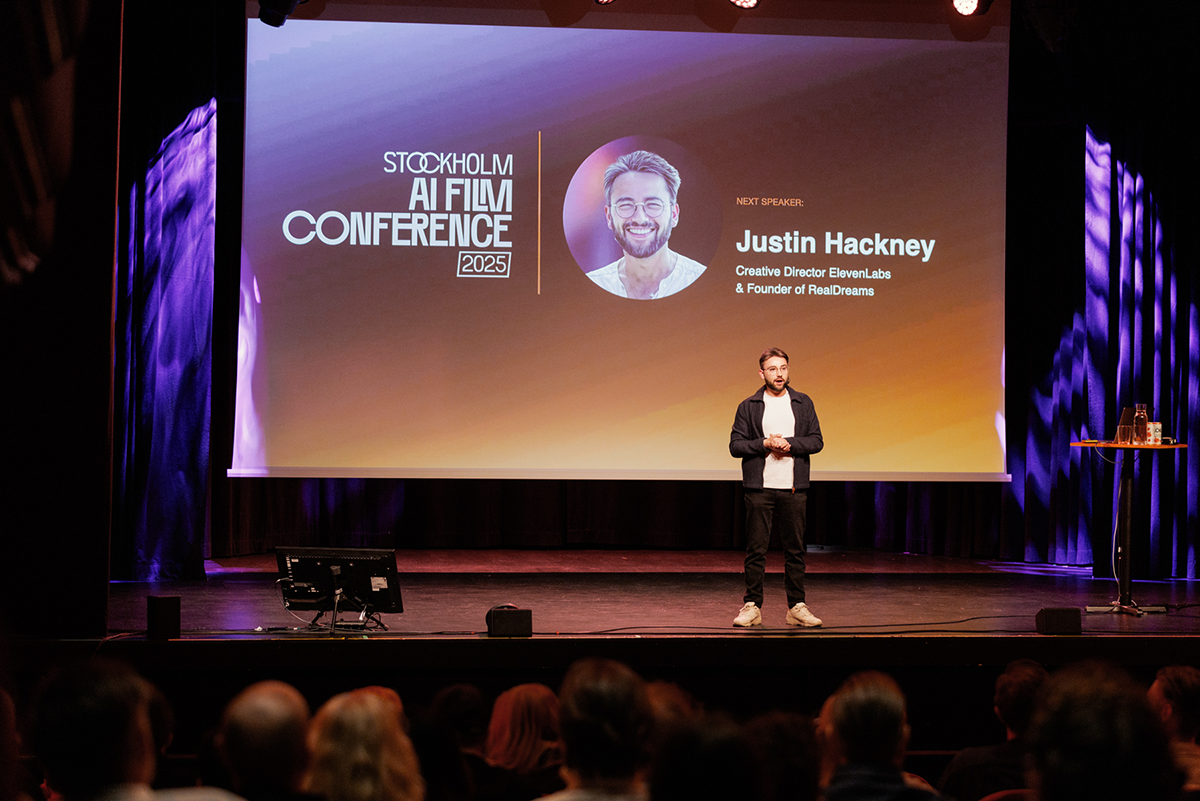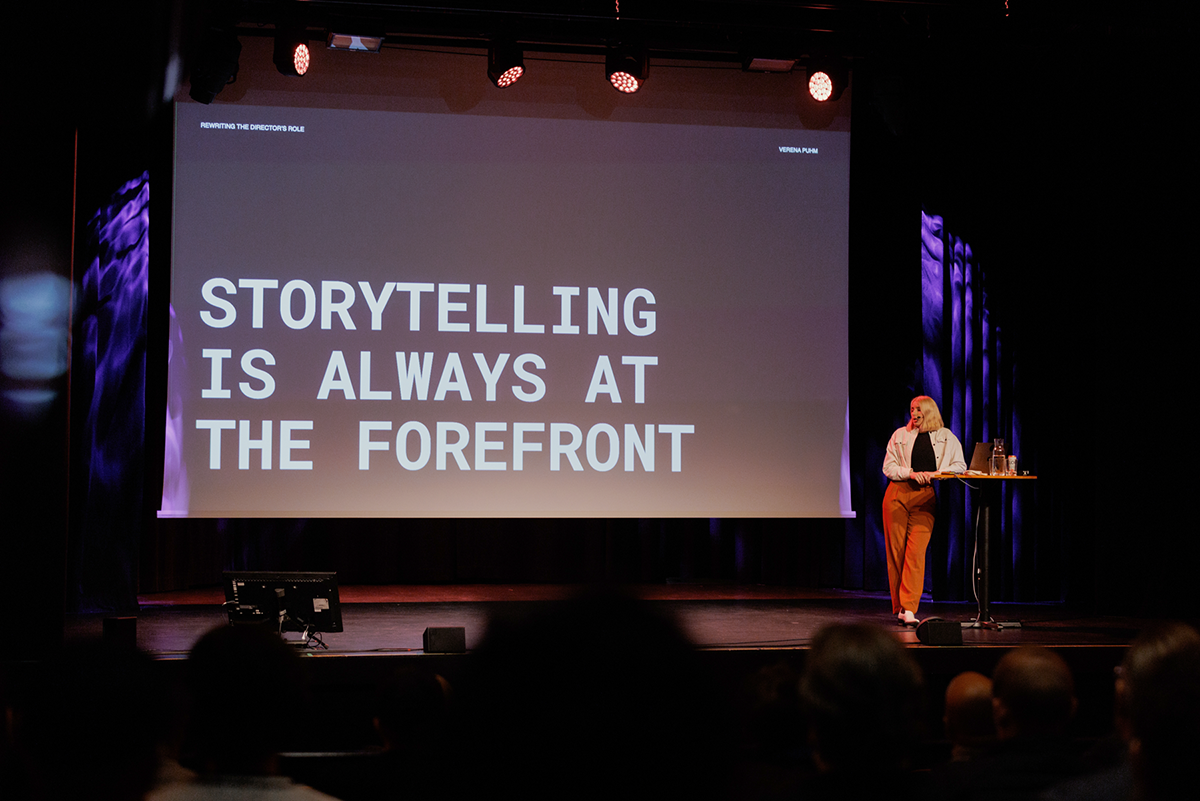STOCKHOLM AI FILM CONFERENCE 2025
HAPPENINGText: Victor Moreno
It was truly inspiring to speak with Justin Hackney, an AI visionary bridging tradition and innovation, paving the way for AI creators to enter the mainstream. With 15 years in traditional filmmaking, Hackney transitioned to AI after working at OpenAI, where he introduced AI tools to artists. He later joined ElevenLabs, helping scale AI-driven audio tools for dubbing and voice cloning. He founded RealDreams, an artist collective supporting creators. Now, he’s taking a bold new direction. “I’m setting up a whole new studio, which is AI native,” he explains. This new venture, called Wonder Studios, represents a significant step forward from his community-focused work.

Justin Hackney, Creative Director ElevenLabs & Founder of RealDreams
“We are going full force into the void.” Wonder has secured $3.5 million to foster talent in AI filmmaking, primarily focusing on short films. The company uses festivals as a talent discovery tool, flipping the traditional approach by recently offering $75,000 in prizes and attracting 4,500 submissions. It’s about giving creators more opportunities to bring their biggest visions to life. “The festival model works because it offers free tools and asks creators to show what they can do,” Hackney explains. From thousands of submissions, about 200 stand out, with 25 emerging as true gems. “Those 25 are the ones we want to nurture, connect, and elevate through distribution.” Wonder supports filmmakers in two ways: some use AI to develop concepts and secure funding, reducing investment risk. “Trying something untested with audiences is always a huge risk, but now you can showcase it before even securing financing,” he says. Others create fully AI-generated films but still need support in sound design, editing, marketing, legal issues, and distribution, much like how a music label supports artists. The studio is building its own platform while securing partnerships with major channels. “By year-end, we aim to be on Prime, hopefully Netflix, our own platform, and possibly TV in some regions,” Hackney notes. Instead of replacing traditional filmmaking, AI is unlocking new opportunities. “We’re helping the next Tarantinos and Danny Boyles.”

Verena Puhm, Awarded Gen AI Director & TV Producer
Award-winning Austrian producer, director, and TV writer Verena Puhm explained “AI-generated media has profoundly transformed my professional work beyond experimentation. I’ve led AI teams on high-profile productions, including the Sundance 2025 hybrid documentary Free Leonard Peltier and an upcoming Cannes premiere. AI has become a core part of our storytelling and visual development pipeline, enabling rapid style prototyping and creative world building that were previously impossible. As someone straddling art and technology, I was struck by how our most innovative work will emerge not from isolated expertise, but from our ability to remain adaptable, curious, and open to unexpected connections that can transform how we understand creativity itself.” Asked about looking in 2025 she sees AI becoming a serious creative partner, not replacing roles, but augmenting them. “I’m excited about real-time collaboration across departments and integrating AI into live-action, animation, and VFX while maintaining a director’s vision. Critically, I anticipate a growing emphasis on ethical and culturally sensitive datasets as AI-generated content expands into more nuanced global spaces.”
Freepik is evolving from a stock content provider into an AI-powered creative platform, aiming to democratize AI. CXO Martin LeBlanc explains, “We’ve integrated various technologies, from Runway to Chinese models like Kling – along with multiple image models.” Their vision is an all-in-one platform where users can seamlessly switch between tools under a single subscription. “One key benefit is that users can explore different options without committing to multiple services.” Balancing professional control with accessibility is crucial. While tools like ComfyUI offer deep flexibility, LeBlanc notes their complexity limits mainstream adoption. Their ultimate goal is democratization: “Our vision is to pull the complexity out of the tools like ComfyUI and make them accessible for anyone who wants to create.”
Another fascinating opportunity at the event was to hang and chat with attendee AI Educator Sebastian Kamph. He has taught AI tools like Stable Diffusion, Flux, and ComfyUI to over 10 million people. After 20 years in advertising, most recently working with Lexus, he shifted to AI and now educates 160,000+ YouTube subscribers. “AI changed everything,” Kamph says. “It cut my workflow from days to hours and flipped my career. Before, I sent out job applications; now, companies reach out to me.” He splits his time between teaching, consulting, and production. “In the open source scene, people want to be free, and they want control. I’m mostly about control, which is why I often use ComfyUI” but he recommends Swarm “It is basically ComfyUI with a user interface on top. for a more user-friendly experience.” Looking ahead, Kamph points to an emerging trend: “The biggest things happening this year are Chinese AI video models. What they’re releasing into the open source community is amazing – in ways better than what we get from closed source tools.”
We also spoke with Max Larsson, a cinematographer and AI visual artist with over 15 years of experience in worldwide commercial and fashion projects who has transitioned to working with AI full-time over the past three years. “If you have an idea, you can make it happen quickly,” Max explained. “You can explore new territories, do things that would cost a lot of money and require big crews. You can also use it to create proof of concepts and spec ads, showing clients early tests to convince them to pursue projects that could be hybrid or fully AI-driven.” Currently running Visionart his AI production company alongside his wife Jennie Larsson, Max sees 2025 as a year of greater AI acceptance in the industry: “More production companies will accept it, more people want to take the leap into production, more features will be released. There’s so much that will happen,” he concludes.
Read more ...





